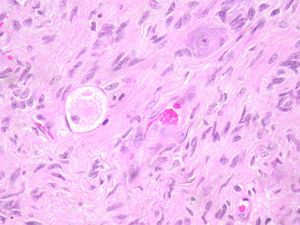Category:Intestine - Functional Obstruction
Paralytic Ileus
Dysautonomia
- Most notably affects horses and cats.
Equine dysautonomia, or grass sickness
- Most prevalent in the UK and western Europe.
- Common in wetter areas, e.g. the South West.
- Seen in horses out at pasture in late summer and autumn.
- Usually affects young adults.
- 6-7 years old.
- Clinical
- Acute oneset:
- Muscular tremors
- Abdominal pain
- Does not eat
- Constipation
- Become severly tympanic in acute cases
- Dull and restless
- Avoid swallowing
- Salivate excessively
- Degenerative lesions are seen in the autonomic nerve ganglia, including enteric plexuses
- May either:
- Progress rapidly to death
- Take a slower clinical course.
- Eat a bit, but food drops out of mouth
- Go on to die slowly.
- Some horses recover
- This is very unlikely, and the condition is usually fatal.
- Clinically difficult to diagnose - signs are confined to the gut.
- Easy to diagnose on post mortem
- Acute oneset:
- Pathology
- Stomach and small intestine large amounts of contain watery yellow fluid.
- There is an abrupt change in the large intestine, where no fluid is present.
- large intestine has very dry mucoid contents.
- There is an abrupt change in the large intestine, where no fluid is present.
- Stomach and small intestine large amounts of contain watery yellow fluid.
- Pathogenesis
- Due to functional obstruction at ileocaecal valve and a degree of paralytic ileus of the small intestine.
- The exact cause is unknown, but a type of bacterial or fungal toxin which may damage autonomic nervous system ganglia may be involved.
- Clostridium botulinum is thought to be involved.
- A similar condition seen in hares
- Certain yeares almost seem to have outbreaks.
- Certain pastures at certain times of year produce grass sickness quite often.
- A definitive diagnosis must be made - if the condition is due to the grazing we need to know.
- E.g. if on livery or stud grazing, may put people off going there.
- A definitive diagnosis must be made - if the condition is due to the grazing we need to know.
- 'Diagnosis
- At post mortem look for degenerative changes in coeliaco-mesenteric ganglia - need to examine histologically.
- Ganglia are peanut sized and found in perirenal fat between adrenal gland and the aorta.
- At post mortem look for degenerative changes in coeliaco-mesenteric ganglia - need to examine histologically.
Feline dysautonomia, or Key-Gaskell Syndrome
- Occurs mostly in the UK and continental Europe.
- Is also of unknown aetiology. Suggested causative factors include:
- Environmental toxins
- Infectious agents
- Botulinum toxins .
- Clinical signs:
- Anorexia
- Depression
- Bradycardia
- Decreased lacrimation,
- Altered pupillary dilataion,
- Megaoesophagus
- Constipation.
- Degenerative lesions of autonomic nerve ganglia can be seen.
- Also occurs in the oesophagus.
Pages in category "Intestine - Functional Obstruction"
The following 3 pages are in this category, out of 3 total.
